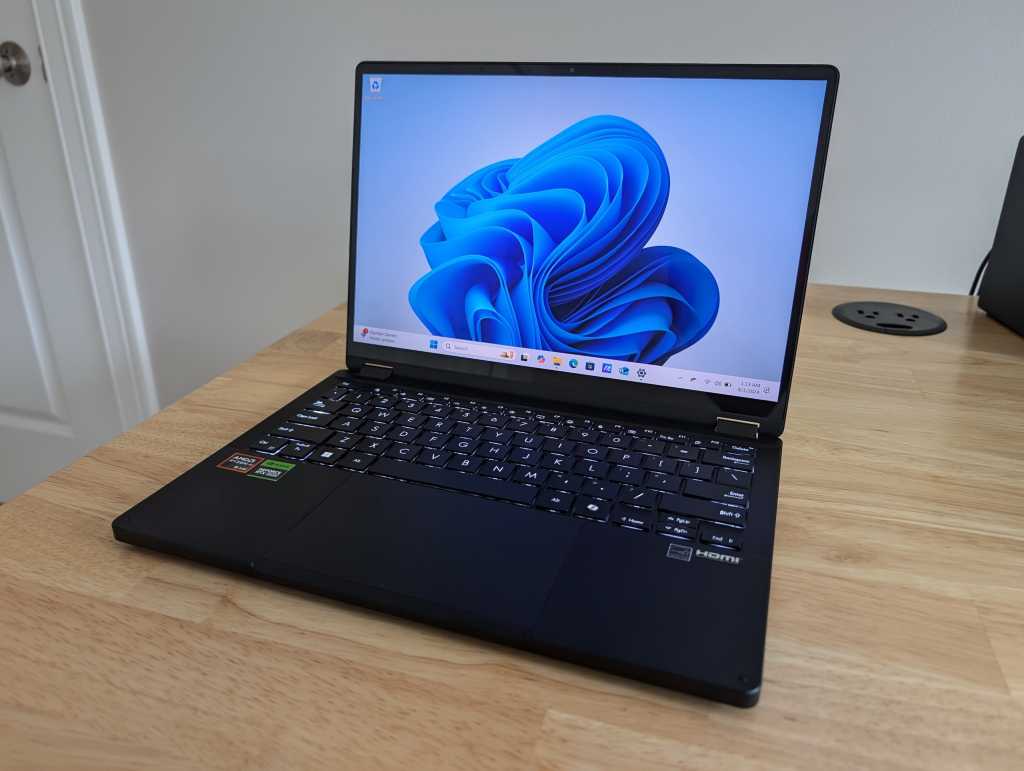 At a look
At a look
Professional’s Score
Professionals
- Glorious multithreaded CPU efficiency
- Stunning OLED display screen
- Discrete Nvidia GPU for inventive duties
- “AI PC” {hardware} with conventional x86 utility compatibility
Cons
- Decrease battery life than a Snapdragon X laptop computer
- Followers may be loud
- No Copilot+ PC AI options at launch
Our Verdict
The Asus ProArt PX13 is a creator-focused laptop computer with spectacular CPU efficiency due to its AMD Ryzen AI 300 collection {hardware}. However, whereas this x86 machine has energy and wonder, AMD’s newest {hardware} nonetheless falls behind Arm PCs in relation to fan noise and battery life.
The Asus ProArt PX13 is a transportable PC supposed for creators. It’s one of many first laptops on the market with the brand new AMD Ryzen AI 9 HX 370 processor. New CPU apart, this PC packs a lot of different helpful options for creators, together with a devoted Nvidia RTX 4050 GPU, 32GB of RAM, and a lovely OLED show with a touchscreen that additionally helps pressure-sensitive stylus enter. It has a 360-degree hinge so you possibly can lie it flat, too.
It is a high-quality PC for creators, and that AMD Ryzen {hardware} takes it to the subsequent degree. As we’ve already seen in a few of our AMD Ryzen AI 300 benchmarks, that is “fairly, fairly, fairly darn good” {hardware} from AMD.
Additional studying: Finest laptops for video modifying 2024: Work sooner with these skilled picks
Asus ProArt PX13: Specs
The Asus ProArt PX13 has spectacular specs. It features a AMD Ryzen AI 9 HX 370 CPU in addition to a whopping 32GB of RAM, making certain loads of reminiscence for inventive functions.
AMD’s Ryzen AI platform features a neural processing unit (NPU) with “as much as 50 TOPS” (trillion operations per second) of efficiency. This implies it beats the NPU in these Snapdragon X-powered Copilot+ PCs – at the very least on paper. And, not like these Snapdragon X Elite and Snapdragon X Plus-powered laptops, this machine is a conventional x86 pc with full compatibility with conventional Home windows software program – no Prism translation layer required.
On high of that, you get a discrete Nvidia GPU. The $1,699 base mannequin we reviewed consists of an Nvidia RTX 4050 GPU, whereas Asus additionally sells a $1,999 mannequin that comes with an Nvidia RTX 4060 GPU. A discrete Nvidia GPU like this one might be one thing many inventive professionals are in search of, whether or not they’re doing graphical rendering or native AI duties. That is one more characteristic that Arm-powered Home windows PCs don’t provide – with Snapdragon, you’re restricted to the onboard Qualcomm Adreno GPU.
It’s value noting that the Asus ProArt PX13 doesn’t embody a pen. You’ll have to purchase a pen just like the Asus Pen 2.0 individually to benefit from the display screen’s stylus assist.
- CPU: AMD Ryzen AI 9 HX 370
- Reminiscence: 32GB LPDDR5X 7500 MHz
- Graphics/GPU: Nvidia RTX 4050, AMD Radeon 890M
- Show: 13.3-inch 2880×1880 OLED show with 60Hz refresh fee, touchscreen, stylus assist
- Storage: 1 TB PCIe 4.0 SSD
- Webcam: 1080p webcam
- Connectivity: 2x USB Sort-C (USB4), 1x USB Sort-A (USB 3.2 Gen 2), 1x combo audio jack, 1x HDMI 2.1, 1x microSD reader, 1x energy in
- Networking: Wi-Fi 7, Bluetooth 5.4
- Biometrics: IR digital camera for facial recognition
- Battery capability: 73 Watt-hours
- Dimensions: 11.74 x 8.26 x 0.7 inches
- Weight: 3.04 kilos
- MSRP: $1,699 as examined
Asus ProArt PX13: Design and construct high quality
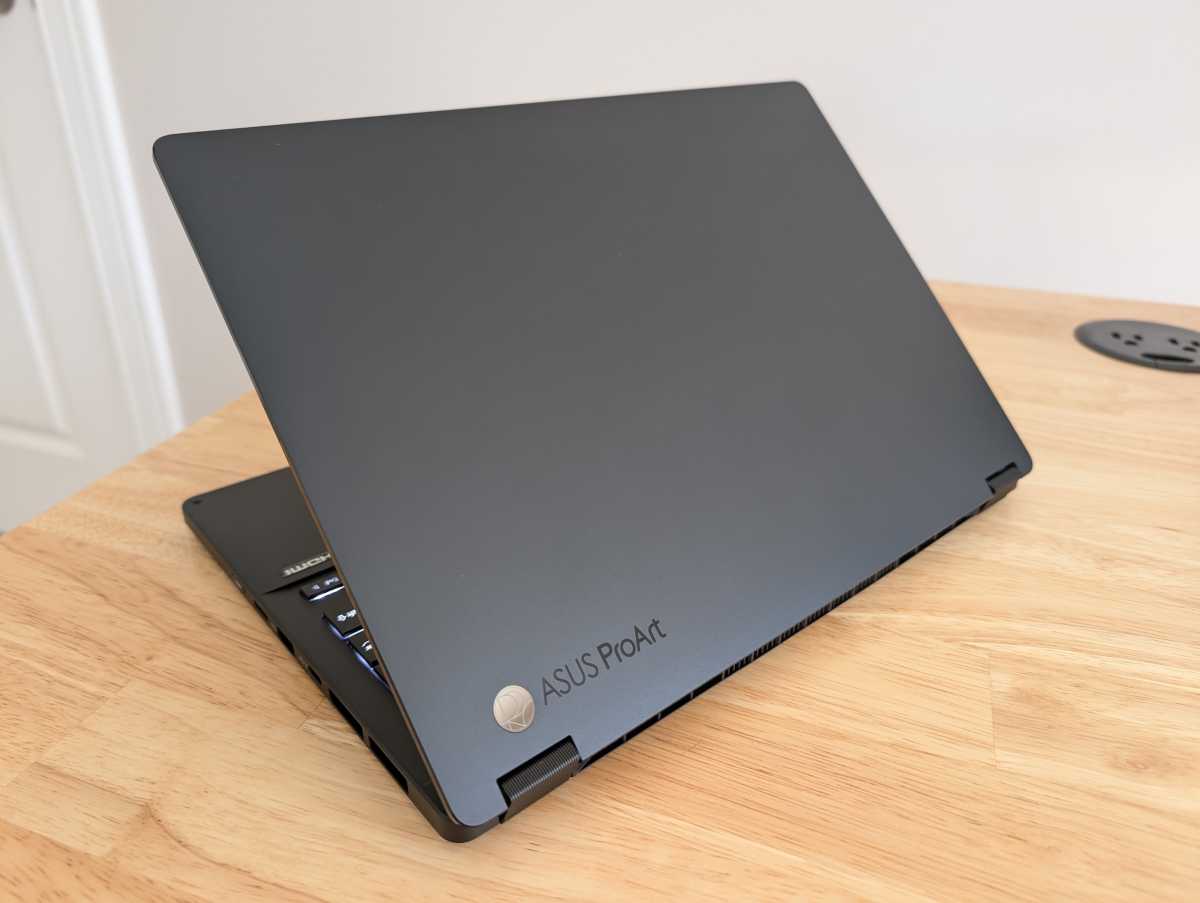
IDG / Chris Hoffman
IDG / Chris Hoffman
IDG / Chris Hoffman
The Asus ProArt PX13 has nice construct high quality with an all-aluminum chassis. The hinge works nicely – it’s simple to open with one hand and the display screen doesn’t transfer or wobble as you sort. The all-black design seems to be good to me, with a chic “Asus ProArt” emblem on the lid. It has a 360-degree hinge so you possibly can rotate it right into a “tent” mode or lie it flat on a floor for drawing.
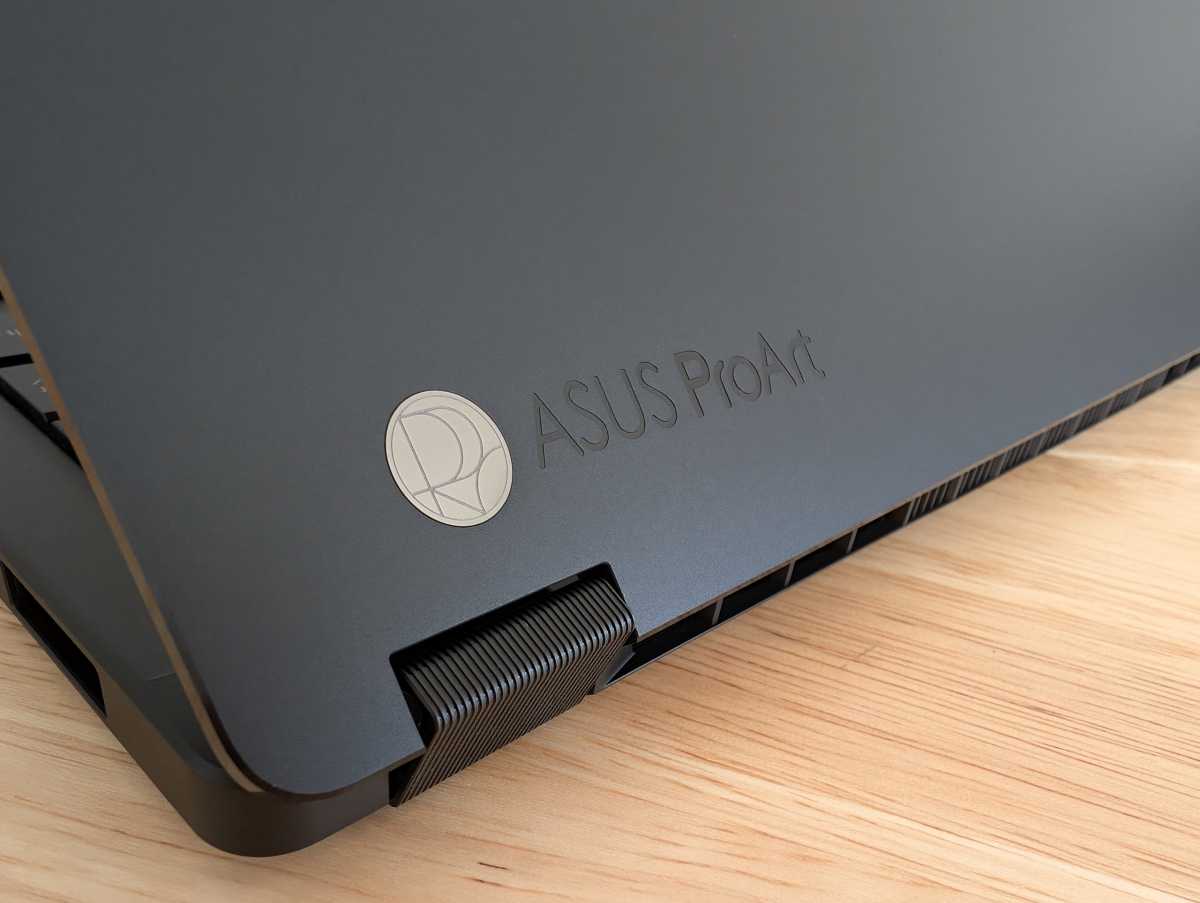
IDG / Chris Hoffman
IDG / Chris Hoffman
IDG / Chris Hoffman
Asus touts the laptop computer’s “nano black” end, stating that its “anodizing course of creates a nano-microporous construction that minimizes reflections, making certain the laptop computer’s smooth ultra-black look in any lighting.” Asus additionally goes out of the way in which to tout the hydrophobic nature of the coating, stating that it produces a “smudge-resistant end” that repels fingerprints. All of it provides as much as a really good, premium-looking end.
Beginning at $1,699 with all this {hardware} — the screaming-fast AMD CPU, vivid OLED display screen, discrete Nvidia GPU, 32GB of RAM, and 1TB of storage mixed with good construct high quality — it’s a compelling bundle for those who’re in search of a 13.3-inch laptop computer.
This 13.3-inch laptop computer is 3.04 kilos, which is simply barely heavier than Snapdragon X-powered laptops like Microsoft’s Floor Laptop computer. It’s good and transportable. Contemplating it is a conventional x86 laptop computer that packs a discrete Nvidia GPU, that’s spectacular. It feels strong and well-made.
This PC has very efficient followers, however they are often very loud. It isn’t the sort of “cool and quiet” on a regular basis PC expertise you discover on an Arm-based Snapdragon X-powered PC. The fan is usually audible in day-to-day pc use, not like with a Snapdragon X-powered laptop computer.
Asus ProArt PX13: Keyboard and trackpad

IDG / Chris Hoffman
IDG / Chris Hoffman
IDG / Chris Hoffman
The Asus ProArt PX13 has a formidable chiclet keyboard that feels nice to sort on. It’s one of many snappier keyboards I’ve used exterior of a mechanical keyboard. The laptop computer’s key journey distance of 1.7mm performs an necessary position right here, I’m positive. There’s nothing mushy in regards to the motion on this keyboard. It’s a nicely laid-out keyboard with white backlighting and the compulsory Copilot key for launching Microsoft’s AI chatbot.
The Asus ProArt PX13 has a trackpad with an attention-grabbing characteristic. The trackpad itself is an effective measurement that feels nice to make use of and swipe your finger over, and palm rejection isn’t an issue. Nonetheless, whereas it’s a pleasant trackpad, the press expertise doesn’t really feel as good because the sort of click on you’ll get on a haptic touchpad like these in Microsoft’s newest Floor Laptops.
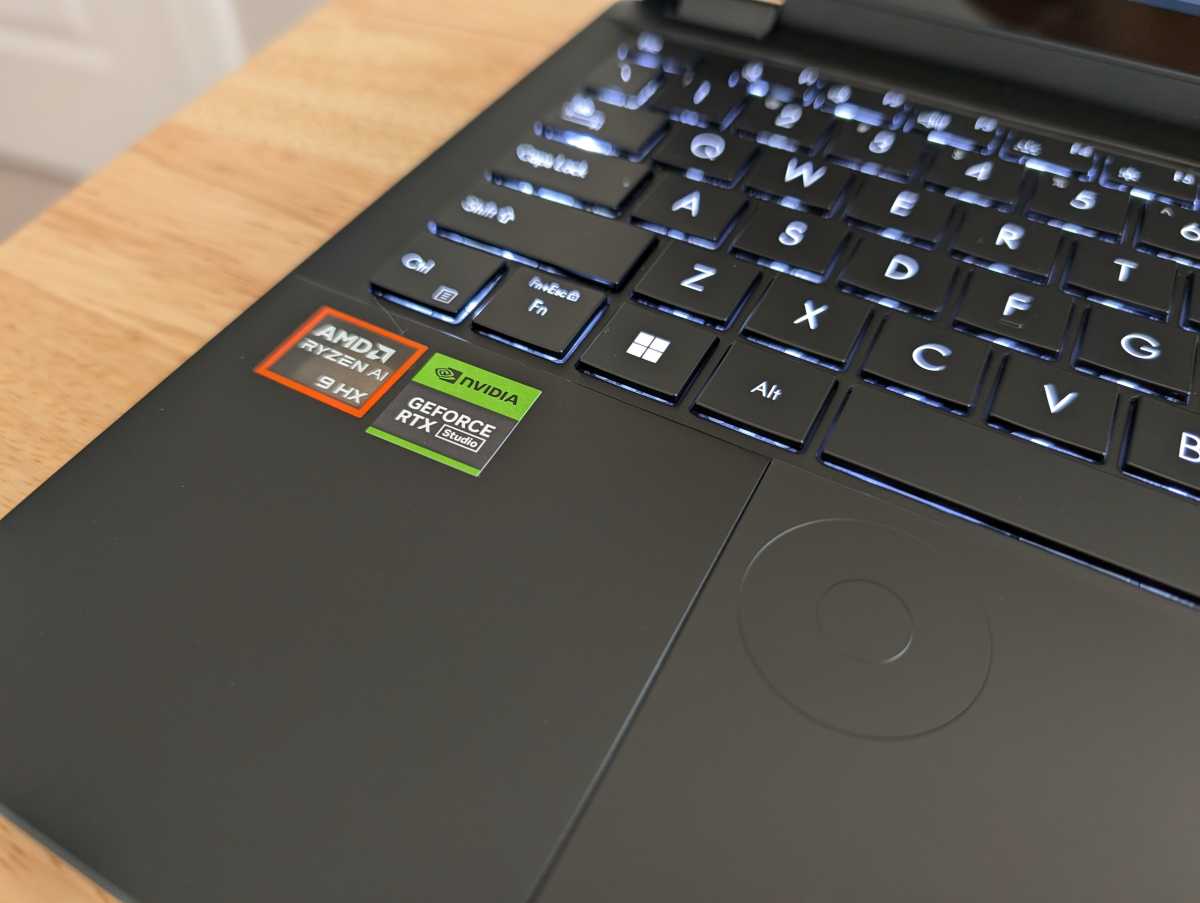
IDG / Chris Hoffman
IDG / Chris Hoffman
IDG / Chris Hoffman
The trackpad consists of an “Asus DialPad” on the top-left nook. To activate the Asus DialPad, you’ll contact the top-right nook of the touchpad after which diagonally, down and down the left. A small LED gentle will activate contained in the DialPad. You may then contact and rotate it to pick out completely different choices in numerous functions. It’s a neat characteristic and is extremely customizable utilizing the “Asus Dial & Management Panel” utility included with the PC. It really works in all kinds of functions, together with Adobe Photoshop. Asus sees you utilizing the dial as a handy solution to modify brush sizes, for instance, with out keyboard shortcuts or clicking round together with your mouse.
Asus ProArt PX13: Show and audio system

IDG / Chris Hoffman
IDG / Chris Hoffman
IDG / Chris Hoffman
The Asus ProArt PX13’s show is the star of the present. This vivid 13.3-inch OLED show delivers 2880×1880 (3K) decision with a 60Hz refresh fee and 500 nits of peak brightness. That’s a 16:10 side ratio, which is nice for work. It additionally includes a contact display screen and assist for a stylus with a number of stress ranges – though, once more, Asus doesn’t embody a stylus with this PC. That’s bought individually.
Some individuals will quibble with the 60Hz refresh fee. You may undoubtedly get shows with the next refresh fee. However it is a creator-focused laptop computer, not a gaming laptop computer. The OLED is gorgeous and Asus prioritized different specs above refresh fee, which I really feel is comprehensible. Additionally, this laptop computer already doesn’t have the longest battery life, and the next refresh fee would additional eat into it.
The Asus ProArt PX 13 has high-quality audio system. They’re “Harman Kardon” licensed audio system. Asus says the audio system “output louder volumes with richer depth and higher surround-sound results, in comparison with laptops of an identical measurement.” That’s a good evaluation: They’re lots loud and so they delivered a greater sound expertise than the audio system in a typical 13-inch laptop computer when watching films. Lack of bass is all the time a difficulty with all however essentially the most premium of audio system within the beefiest of gaming laptops, however this laptop computer’s speaker setup sounds unusually good for its measurement.
Asus ProArt PX13: Webcam, microphone, biometrics
The Asus ProArt PX13 features a 1080p webcam, and it seems to be good – I’d be completely happy to make use of it in video conferences.
There’s one shocking factor in regards to the webcam setup: This laptop computer doesn’t embody Home windows Studio Results, an AI-based webcam characteristic constructed into Home windows that requires a neural processing unit (NPU.) That is the one AI characteristic I anticipated to search out constructed into Home windows – it was additionally accessible on Intel’s Meteor Lake laptops, which launched earlier than Copilot+ PCs. Maybe this characteristic will arrive if and when this PC turns into “Copilot+ PC” licensed and beneficial properties entry to different AI options constructed into Home windows 11 sooner or later.
Asus says this laptop computer has a “built-in array microphone.” It sounds good and clear, but it surely was a little bit on the quiet facet. Once I opened Home windows settings to show up the microphone quantity, I discovered it was already turned to most. It’s workable, however I’m used to extra quantity from built-in laptop computer microphones out of the field.
The IR digital camera labored nicely right here, utilizing Home windows Whats up to signal me in with facial recognition after I opened the laptop computer or turned it on. This laptop computer doesn’t embody a fingerprint reader – facial recognition is your one possibility for biometrics.
Asus ProArt PX13: Connectivity

IDG / Chris Hoffman
IDG / Chris Hoffman
IDG / Chris Hoffman
The Asus ProArt PX13 has a wide variety of ports. On the left, you’ve acquired a DC energy in jack for the constitution, an HDMI 2.1 port, a USB Sort-C (USB4) port, and a combo audio jack.
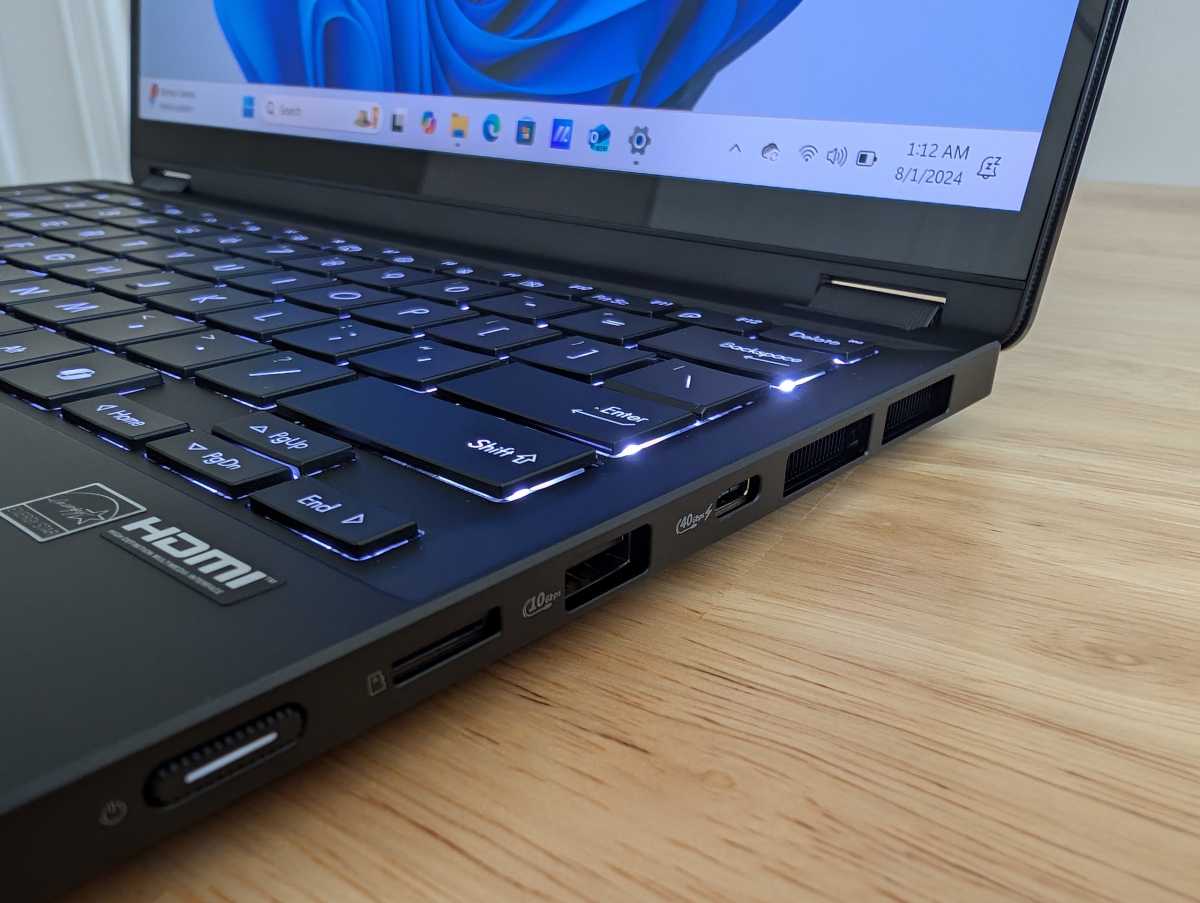
IDG / Chris Hoffman
IDG / Chris Hoffman
IDG / Chris Hoffman
On the proper, this laptop computer has a second USB Sort-C (USB4) port, a USB Sort-A (USB 3.2 Gen 2) port, and a microSD card reader slot subsequent to the facility button. That’s about what you’ll be in search of in a laptop computer of this measurement. You may all the time get a dongle for those who want an Ethernet connection or extra ports.
The Asus ProArt PX13 additionally consists of {hardware} that helps Wi-Fi 7 and Bluetooth 5.4. It’s excessive time trendy {hardware} platforms are together with Wi-Fi 7 as a typical characteristic. Even for those who don’t have a Wi-Fi 7 router but, it’s good to have for future proofing.
What about Copilot+ PC options?
The Asus ProArt PX13 features a neural processing unit (NPU) with as much as 50 TOPS (trillion operations per second) of efficiency. That is sooner than the NPUs discovered within the first wave of Copilot+ PCs, that are powered by Arm-based Snapdragon X Elite or Snapdragon X Plus chips.
Regardless of that, this PC doesn’t have any of these Copilot+ PC options – which, to be truthful, are underwhelming proper now anyway. As talked about above, this PC doesn’t even embody Home windows Studio Results for webcam results, regardless of that bundle of results being accessible on Intel’s Core Extremely-powered Meteor Lake laptops, which launched earlier this yr.
AMD has stated it expects Copilot+ PC options will arrive through Home windows Replace by the top of 2024, however Microsoft hasn’t publicly dedicated to that timeline. Microsoft has not been clear about precisely when these PCs will get Copilot+ PC options, and that’s unlucky. With the controversial Recall characteristic delayed, Microsoft’s messaging round these Copilot+ PC AI options could be very messy on the whole. The identical might be true for different AMD Ryzen AI-powered laptops in addition to Intel’s forthcoming Lunar Lake-powered methods.
We don’t have a good way to benchmark the efficiency of the NPU (neural processing unit) simply but. That’s very true since few inventive functions are utilizing the NPU at this second. AMD has gone out of its solution to exhibit the NPU in some methods, bundling two functions: MuseTree is an utility that offers you “inspiration,” and it’ll generate a tree of AI-generated photos and concepts for you. StoryCube is designed to import photos and video and set up them with AI. They’re attention-grabbing, and it’s good to see Asus attempt to do one thing inventive.
Asus ProArt PX13: Efficiency
The Asus ProArt PX13 supplied nice efficiency in day-to-day pc use. With the newest AMD Ryzen AI 9 HX 370 CPU, a discrete Nvidia GeForce RTX 4050 GPU, 32GB of RAM, and a 1TB SSD, that’s precisely what we’d anticipate to see – there’s no shock there.
However simply how does this x86 laptop computer stack as much as current choices from Intel, just like the competing Intel Core Extremely “AI PCs” with present Meteor Lake {hardware}? As all the time, we ran the Asus ProArt PX13 by way of our commonplace benchmarks to see the way it performs.
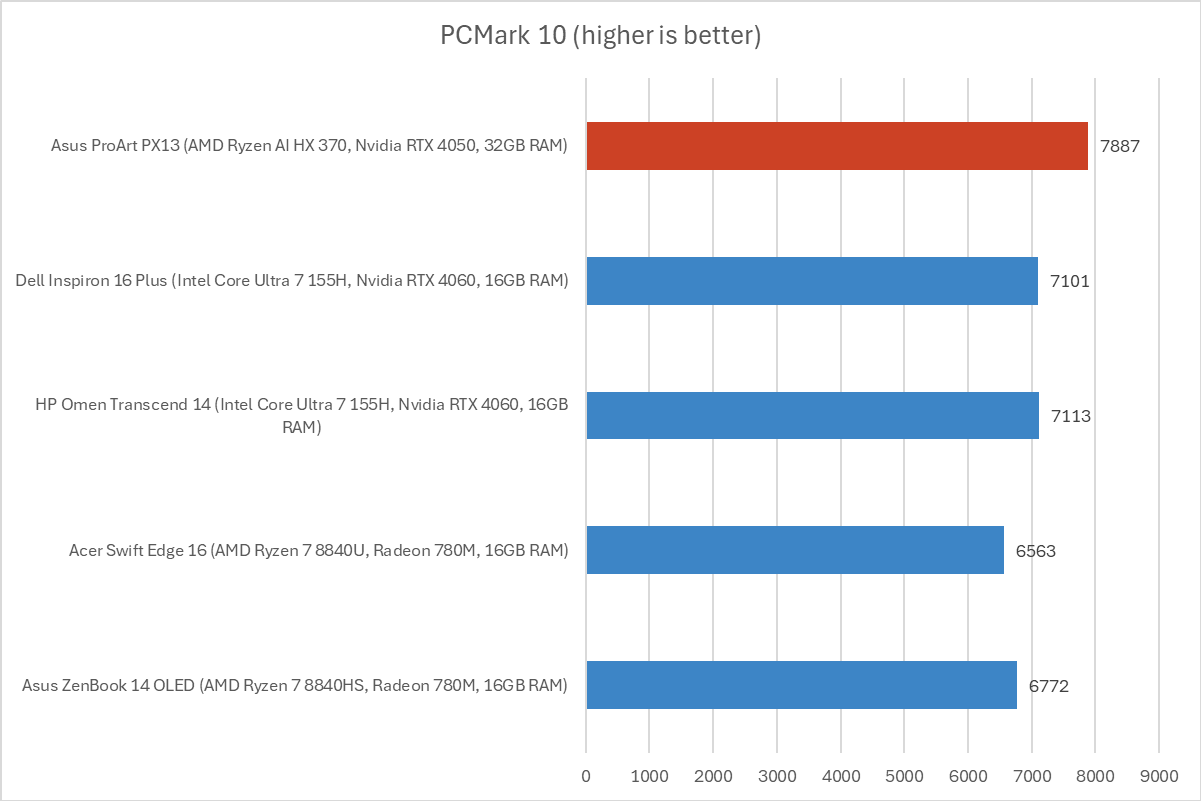
IDG / Chris Hoffman
IDG / Chris Hoffman
IDG / Chris Hoffman
First, we run PCMark 10 to get an concept of general system efficiency. Whereas this benchmark is designed to be a take a look at of holistic system efficiency, it’s significantly centered on the CPU.
With an general PCMark 10 rating of seven,887, the Asus ProArt PX13 blew away different creator-focused laptops out there just like the Dell Inspiron 16 Plus, which includes a Intel Core Extremely 7 155H CPU. AMD’s newest Ryzen {hardware} is delivering some critical multithreaded efficiency particularly. As we demonstrated in our general Ryzen AI 300 benchmarks, multithreaded efficiency is the place this {hardware} actually shines.
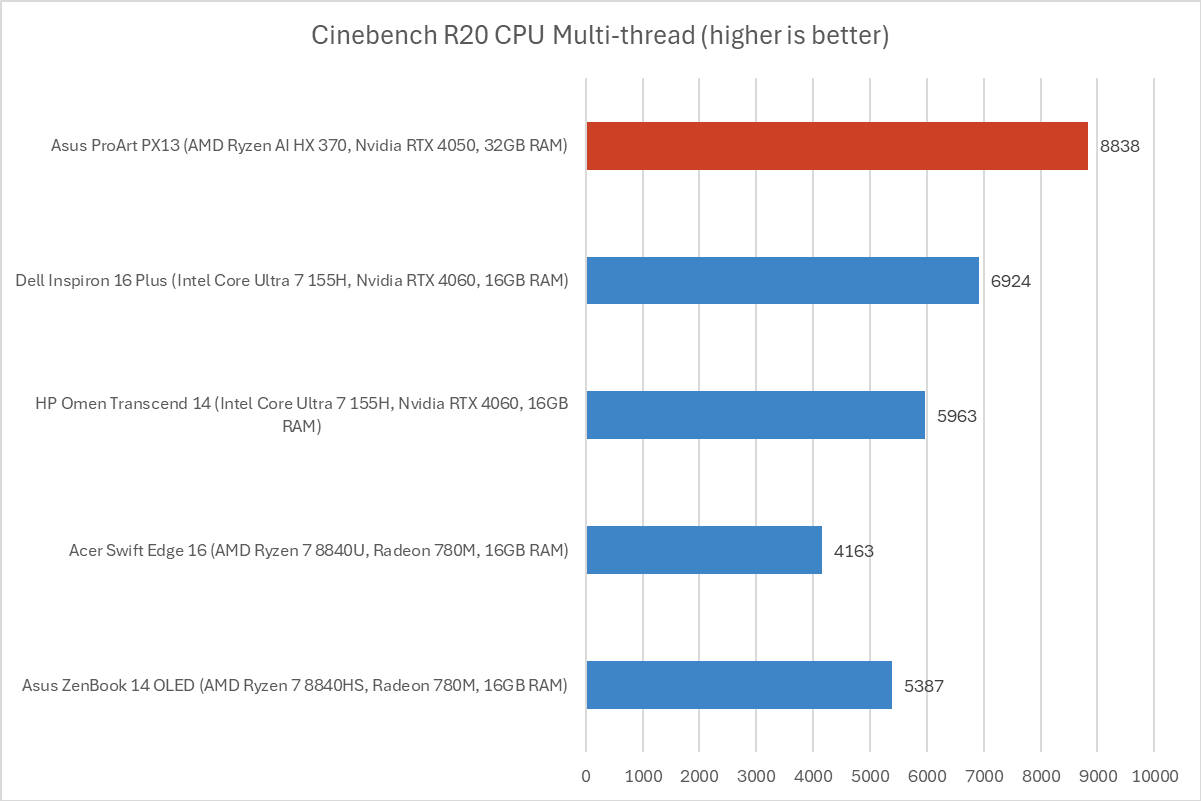
IDG / Chris Hoffman
IDG / Chris Hoffman
IDG / Chris Hoffman
Subsequent, we run Cinebench R20. It is a closely multithreaded benchmark that focuses on general CPU efficiency. It’s a fast benchmark, so cooling below prolonged workloads isn’t an element. However, because it’s closely multithreaded, CPUs with extra cores have an enormous benefit.
With a rating of 8,838, the Asus ProArt PX13 completely blew away the competitors as soon as once more. That is critically spectacular efficiency. I hope Intel’s upcoming Lunar Lake chips delivers some critical multithreaded efficiency beneficial properties to compete.
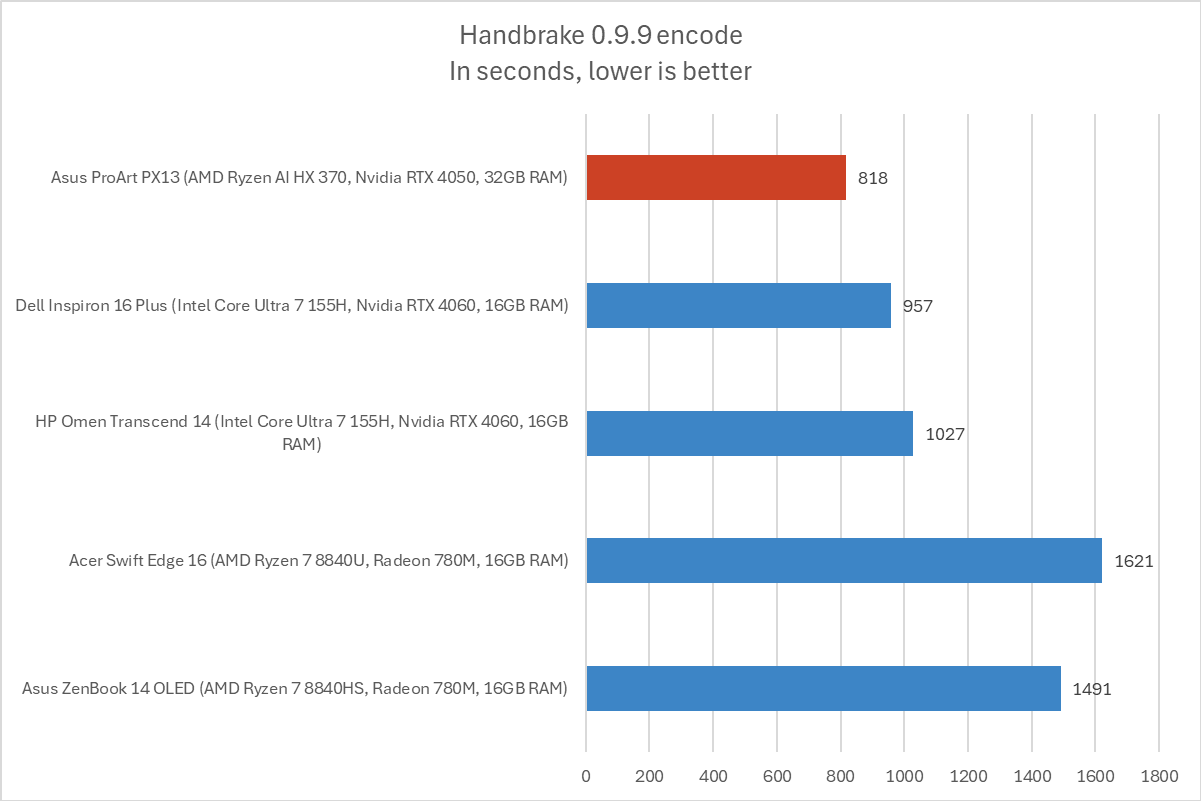
IDG / Chris Hoffman
IDG / Chris Hoffman
IDG / Chris Hoffman
We additionally run an encode with Handbrake. That is one other closely multithreaded benchmark, but it surely runs over an prolonged time frame. This calls for the laptop computer’s cooling kick in and lots of laptops will throttle and decelerate below load.
The Asus ProArt PX13 accomplished the encode course of in 818 seconds – about 13 and a half minutes. Once more, that’s considerably sooner than the Intel Meteor Lake-powered PCs we in contrast it towards.
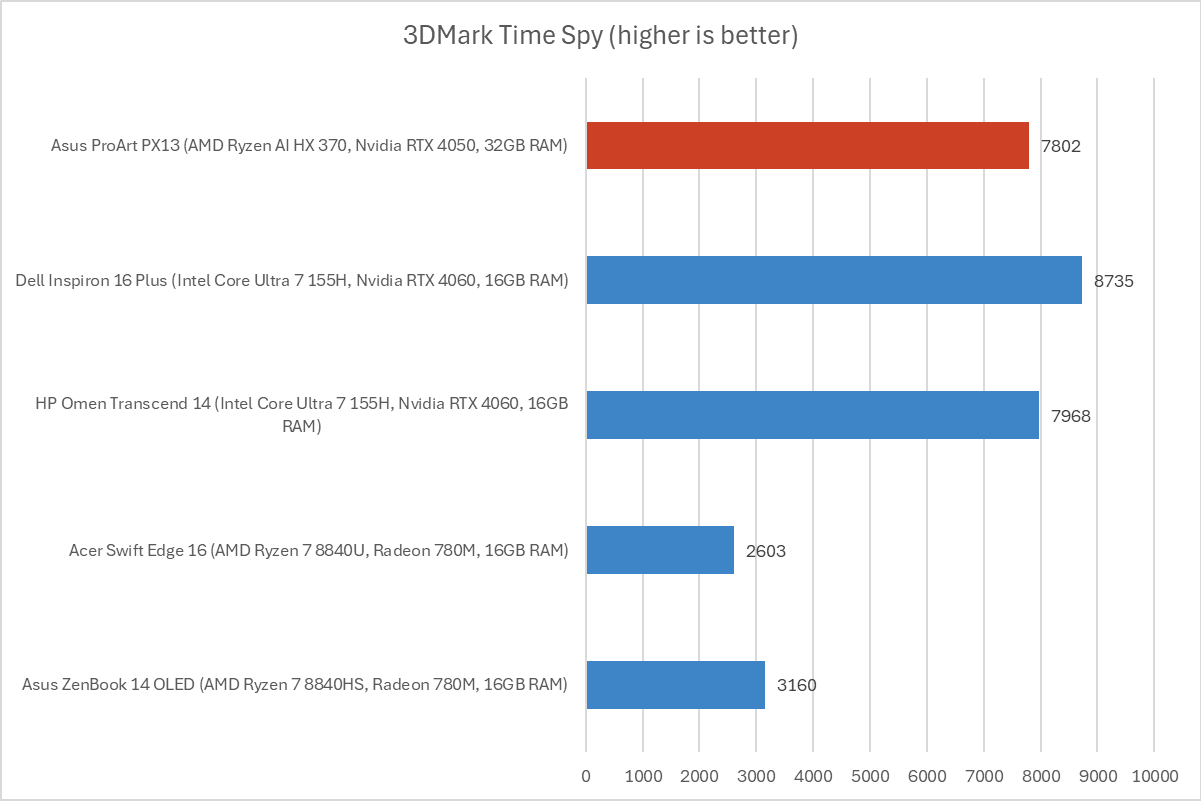
IDG / Chris Hoffman
IDG / Chris Hoffman
IDG / Chris Hoffman
Subsequent, we run a graphical benchmark. Whereas this has an Nvidia GPU, it isn’t a gaming laptop computer. You may play video games on it in a pinch, naturally, however the supposed use of that GPU is 3D rendering, GPU-heavy AI duties, and different inventive workloads. We run 3Dmark Time Spy, a graphical benchmark that focuses on GPU efficiency.
Naturally, the outcomes listed below are all in regards to the GPU. The Asus ProArt PX13, with its Nvidia GeForce 4050, fell behind some GeForce 4060-powered laptops. The model of this laptop computer with the GeForce 4060 would probably catch up.
General, efficiency on this laptop computer was glorious. AMD’s new Ryzen AI 300 collection {hardware} is delivering critical multithreaded CPU energy.
Asus ProArt PX13: Battery life
The Asus ProArt PX13 features a 73 Watt-hour battery. Whereas it is a new CPU from AMD and the business is turning into extra centered on battery life and energy effectivity, AMD has been quieter about battery life. Qualcomm and Intel are competing on lengthy battery life, however AMD appears to be specializing in efficiency.

IDG / Chris Hoffman
IDG / Chris Hoffman
IDG / Chris Hoffman
To benchmark a laptop computer’s battery life, we play a 4K copy of Tears of Metal on repeat on Home windows 11 with airplane mode enabled till the laptop computer suspends itself. We set the display screen to 250 nits of brightness for our battery benchmarks, and it’s value noting that the Asus ProArt PX13’s OLED show has a little bit of a bonus, as OLED screens use much less energy to show the black bars across the video.
It is a best-case state of affairs for any laptop computer since native video playback is so environment friendly, and actual battery life in day-to-day use is all the time going to be lower than this.
In our battery rundown take a look at, the Asus ProArt PX13 lasted for a median of 850 minutes – that’s simply over 14 hours. Whereas that’s an affordable quantity, particularly contemplating the OLED show and the opposite {hardware} this machine consists of, it’s undoubtedly far shorter than present Copilot+ PCs with their Qualcomm Snapdragon X Elite or Qualcomm Snapdragon X Plus {hardware}.
The Floor Laptop computer is an effective instance of Qualcomm’s battery life power: It delivered 1,223 minutes of battery life in our take a look at, which is over 20 hours. And the Floor Laptop computer has a smaller battery at 54 Watt-hours in comparison with the 73 Watt-hour battery on this PC.
Keep in mind that, whereas 14 hours could sound like lots, you’ll get much less in day-to-day use as you really use functions on the laptop computer. This x86-based creator-focused laptop computer has loads of positives, but it surely does fall behind Arm-based Snapdragon X PCs in relation to battery life.
Asus ProArt PX13: Conclusion
The Asus ProArt PX13 is an unimaginable laptop computer. For those who’re a creator in search of a high-quality machine with nice construct high quality, the newest AMD CPU with critically spectacular multithreaded efficiency, a discrete Nvidia GPU, and plenty of RAM, it is a nice machine. It has full compatibility with present x86 software program with no Prism translation layer slowing issues down or inflicting occasional compatibility issues.
Beginning at $1,699 with all this {hardware} — the screaming-fast AMD CPU, vivid OLED display screen, discrete Nvidia GPU, 32GB of RAM, and 1TB of storage mixed with good construct high quality — it’s a compelling bundle for those who’re in search of a 13.3-inch laptop computer.
However, whereas this machine has most of the conventional strengths of an x86 PC, it additionally has its conventional downsides. Battery life is decrease and the fan is surprisingly loud in regular PC use. It’s regular on an x86 laptop computer, particularly one with this sort of {hardware}.
Nevertheless, this machine isn’t for everybody. For those who’ll be doing lighter work and also you don’t want the high-end {hardware} right here, an Arm-powered Snapdragon PC will ship considerably longer battery life mixed with cool and quiet operation.
For those who’re not in a rush to purchase a PC, it’s possible you’ll wish to wait to see opinions of Intel’s Lunar Lake {hardware}. Intel says it’s launching Lunar Lake on September 3, 2024. The corporate has been making large guarantees about each lengthy battery life and unimaginable efficiency beneficial properties. We sit up for reviewing Intel’s new {hardware} and seeing the way it compares.

